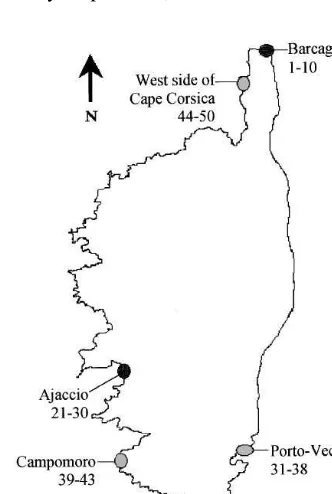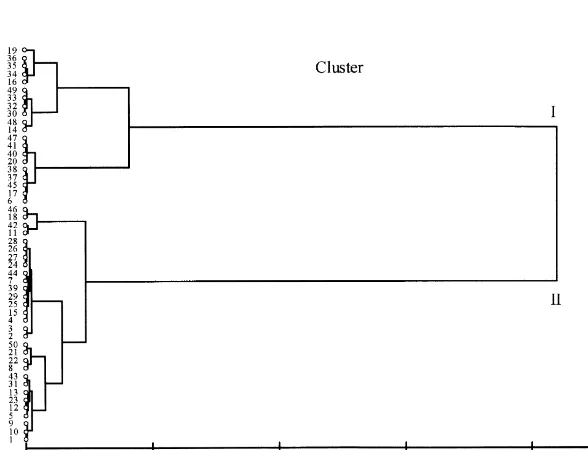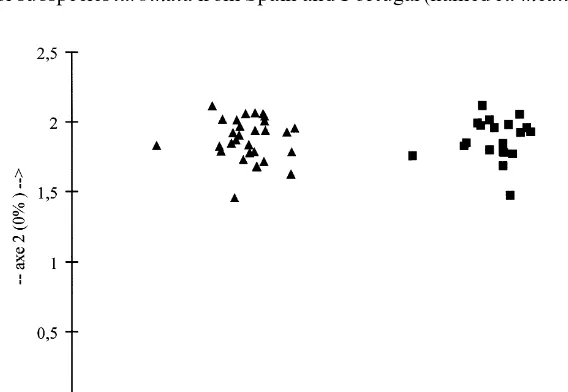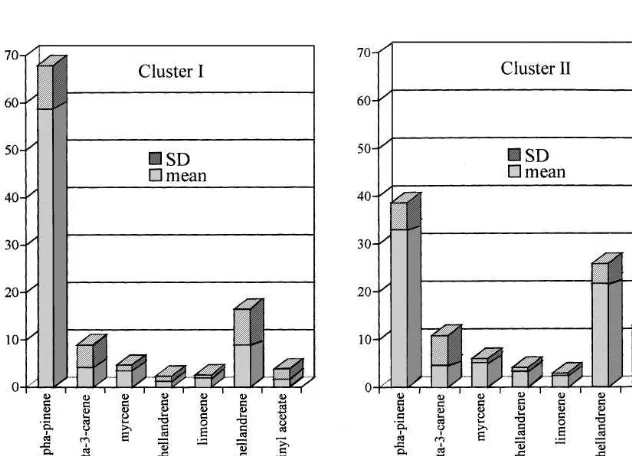Intraspeci
"
c chemical variability of the leaf
essential oil of
Juniperus phoenicea
subsp.
turbinata
from Corsica
Serge Rezzi
!
, Carlos Cavaleiro
"
, Ange Bighelli
!
, Ligia Salgueiro
"
,
Anto
H
nio Proenc
7
a da Cunha
"
, Joseph Casanova
!
,
*
!Universite&de Corse, Equipe Chimie et Biomasse, URA CNRS 2053, Route des Sanguinaires, 20000 Ajaccio,
France
"Universidade de Coimbra, Faculdade de Farma&cia, C.E.F./Laborato&rio de Farmacognosia, Rua do Norte, 3000 Coimbra, Portugal
Received 4 August 1999; accepted 18 October 1999
Abstract
The composition of 50 samples of essential oil of individual plantsof Juniperus phoenicea
subsp.turbinata from Corsica was investigated by GC, GC}MS and 13C NMR. a-Pinene, b-phellandrene,a-terpinyl acetate,D-3-carene, myrcene anda-phellandrene were found to be the main constituents. The results were submitted to cluster analysis and discriminant analysis which allowed two groups of essential oils to be distinguished with respect to the content of a-pinene, b-phellandrene and a-terpinyl acetate. ( 2001 Elsevier Science Ltd. All rights reserved.
Keywords: Juniperus phoeniceasubsp.turbinata; Cupressaceae; Essential oil; GC; GC}MS;13C NMR;
Statistical analysis; Intraspeci"c variability
1. Introduction
The genusJuniperusconsists of approximately 60 species growing in the Northern Hemisphere and divided into three sections: Caryocedrus, Juniperus ("Oxycedrus)
and Sabina, the third being the most important one which comprises Juniperus
*Corresponding author. Tel.:#33-4-95-52-41-21; fax:#33-4-95-52-41-42.
E-mail address:[email protected] (J. Casanova).
phoeniceaL. Recently, Adams (1999) showed on the basis of essential oil composition and RAPD DNA"ngerprinting thatJ. phoeniceais distinguishable from other species of sectionSabina.
J. phoeniceaL. (Cupressaceae) is a shrub or a small tree from the Mediterranean region (Bonnier and Douin, 1990). Two subspeci"c taxa are clearly de"ned consider-ing distinctive botanical features * not always well conspicuous * and phyto-geographic distribution: J. phoenicea subsp. phoeniceaL. characterized by globose female cones and obtuse or subacute scale-leaves, occurring in the inner mainlands andJuniperus phoeniceasubsp.turbinata(Guss.) Parl. Nyman. ("J. phoeniceasubsp.
lyciaAuct."J.turbinataGuss.) having elongated female cones and acute scale-leaves,
occurring in coastal sites (Franco, 1964). According to phytogeographical repartition (Franco, 1964; Paradis, 1991) only the second subspecies grows wild in Corsica.
There is some controversy in the intraspeci"c treatment of J. phoenicea. Several local forms or biochemical pattern types were reported as subspecies or varieties, such as J. phoenicea subsp. eu-mediterranea Lebr. & Tiv. based on the prodel-phinidine/procyanidine ratio in leaves (Lebreton and Thivend, 1981; Lebreton, 1983) but treated by Adams et al. (1996) as conspeci"c withJ. phoeniceasubsp.turbinata.
Essential oil of J. phoenicea is obtained by hydrodistillation of leaves, fruits or wood. There are few reports on the composition ofJ. phoenicealeaf oil, even though they concerned plants from various origins and a limited number of samples were analysed every time. The "rst studies date back to 1956 and 1973 and reported monoterpene-rich oils (subspecies not reported) (Gil de Meister and Ho!man, 1956; Banthorpe et al., 1973). More recently, Vidrich and Michelozzi (1993) reported 1,8-cineole,a-pinene and borneol as major components for an oil from Italy (sub-species not reported). Adams et al. (1996) studied samples from di!erent origins and di!erent subspecies. They reported the following compositions:a-pinene forJ. phoe-nicea (sensu stricto) from inland Greece and Spain anda-pinene/b-phellandrene/a -terpinyl acetate forJ. phoeniceavar. turbinatafrom coastal Spain andJ. phoenicea
subsp. eu-mediterraneafrom coastal Portugal. In this study the authors emphasized the similarity of the essential oil composition of var.turbinataand subsp. eu-mediterra-neaand suggested that these taxa are conspeci"c.
J. phoeniceaberry oils are characterized by a high content ofa-pinene, whatever the origin (Fernandes-Costa and Cardoso do Vale, 1953}1954; Gil de Meister and Ho!man, 1956; Proenc7a da Cuhna et al., 1977; De Pascual Teresa et al., 1981; Vidrich
and Michelozzi, 1993; Falchi Delitala, 1980; Lawrence, 1989). The wood oil contains thujopsene and cedrol as major components (Adams, 1991), whereas pyrolitic oil is characterized by the predominance ofa-cedrene (Chalchat et al., 1990). In addition, acidic and neutral diterpenes (Tabacik and Poisson, 1971; Tabacik and Laporthe, 1971; De Pascual Teresa et al., 1978a,b; Dawidar et al., 1991; San Feliciano et al., 1988, 1992, 1993) have been identi"ed in solvent extracts of leaves and berries of J. phoenicea.
Fig. 1. Sampling ofJuniperus phoeniceasubsp.turbinataleaves from Corsica (dark grey: the three most important locations; light grey: other locations).
from Corsica and to investigate if chemical variability occurred on the well-delimited territory of the island. We planned to collect individual plants from locations covering the geographic range ofJ. phoeniceasubsp.turbinatain Corsica.
2. Materials and methods
2.1. Plant material
J. phoeniceasubsp.turbinatagrows wild in di!erent locations in Corsica as reported by Paradis (1991). In order to study the chemical variability of leaf oils in a delimited area with constant pedoclimatic conditions, we collected 10 samples of single plants in the three most important stations (Fig. 1): Barcaggio (samples 1}10), Bonifacio (11}20), Ajaccio (21}30). Twenty samples were collected in the other locations (Fig. 1): Porto-Vecchio (31}38), Campomoro (39}43), west side of Cape Corsica (44}50). So, all the locations were investigated.
2.2. Sampling and leaf essential oils
using a Clevenger-type apparatus. Essential oil yield, ranged between 0.1 and 0.7% (w/w, from fresh material).
2.3. GC,GC/MS and Carbon-13 NMR analyses
Analytical GC: GC analysis was performed using a Perkin-Elmer Autosystem apparatus equipped with two#ame ionization detectors (FID), and fused capillary columns (50 m]0.22 mm i.d., "lm thickness 0.25lm), BP-1 (polydimethylsiloxane)
and BP-20 (polyethyleneglycol). The oven temperature was programmed from 60 to 2203C at 23C/min and then held isothermal (20 min); injector temperature: 2503C (injection mode: split 1/60); detector temperature: 2503C; carrier gas: helium.
GC/MS: GC}MS was performed with a Hewlett-Packard 6890 gas chromatograph, equipped with a polydimethylsiloxane fused-silica column (30 m]0.25 mm i.d., "lm thickness 0.25lm, HP19091Z-433.) interfaced with a Hewlett-Packard mass selective
detector 5973 operated by HP Enhanced ChemStation software, version A.03.00. The oven temperature was programmed from 70 to 2203C at 33C/min and then held isothermal (15 min); injector temperature: 2503C; carrier gas: helium, adjusted to a linear velocity of 30 cm/s; split 1/40; interface temperature: 2503C; MS source temperature: 2303C; MS quadrupole temperature: 1503C; ionization energy: 70 eV; ionization current: 60lA; scan range: 35}350 u; scans/s: 4.51.
13
C NMR spectra: NMR spectra were recorded on a Bruker AC 200 Fourier transform spectrometer, operating at 50.323 MHz, equipped with a 10 mm probe in deuterated chloroform (around 200 mg of oil in 2 mL of CDCl
3), with all shifts (d) referred to internal tetramethylsilane (TMS). Parameters: pulse width (PW): 5.0ls (#ip
angle 453); acquisition time: 1.3 s and relaxation delay D
1: 2 s (total recycling time 3.3 s) for 32 K data table with a spectral width (SW) of 12 500 Hz (250 ppm); composite phase decoupling (CPD) of the proton band; digital resolution: 0.763 Hz/pt; 5000 scans were accumulated for each sample. An exponential multiplication of the free induction decay with the line broadening of 1.0 Hz was applied before Fourier transformation.
2.4. Identixcation of components
Fig. 2. Dendrogram obtained from the cluster analysis of 50 samples of Juniperus phoenicea subsp.
turbinatafrom Corsica. Samples are clustered using Ward's technique with an Euclidean distance measure.
GC: The components were identi"ed by comparison of their retention indices on polar and apolar columns with those of authentic samples. Retention indices were determined relative to retention times of a series ofn-alkanes with linear interpolation (`Target Compoundsasoftware from Perkin-Elmer). The relative proportions of the essential oil constituents were expressed as percentages obtained by peak-area nor-malization and no correcting factor has been applied.
GC/MS: Identi"cation of the individual components was made by comparison of the acquired spectra with corresponding data from authentic samples or with litera-ture data (Joulain and KoKnig, 1998; McLa!erty and Stau!er, 1989) after a preliminary computer matching into a commercial mass spectra library.
2.5. Data analyses
The data were processed by Cluster Analysis using hierarchical clustering (Ward's technique and Euclidean distance measure) and were submitted to Discriminant Analysis, using thexlSTAT-Pro software (Thierry Fahmy, France).
3. Results and discussion
Fig. 3. Discriminant analysis scatterplot of 50 samples of Juniperus phoenicea subsp.turbinata from Corsica. (j) Cluster I, (m) Cluster II.
the total oil were identi"ed (Table 1). Thirty components over 0.4% representing from 80.3 to 95.8% of the whole chemical composition were taken into account for statistical analysis. The dendrogram (Fig. 2) suggested the existence of two clusters (clusters I and II). Discriminant analysis (DA) (Figs. 3 and 4) con"rmed this clustering and the two-dimensional axial system originated in the DA distinguished the di!erent types of essential oils based on the contents ofa-pinene,b-phellandrene anda-terpinyl acetate.
The essential oils of cluster I (40% of the samples) are characterized by a high content ofa-pinene (mean 58.7%, S.D."9.2) (Fig. 5). The chemical composition of
samples of cluster II (60% of the samples) is characterized by the weakest content of
a-pinene (mean 33.0%, S.D."5.6) and a signi"cant content ofb-phellandrene (mean
21.1%, S.D."4.1) anda-terpinyl acetate (mean 8.2%, S.D."4.6) (Fig. 5). So, the leaf
oils ofJ. phoeniceasubsp.turbinatafrom Corsica exhibit a chemical variability with two clear composition patterns: a-pinene and a-pinene/b-phellandrene/a-terpinyl acetate. Both composition patterns are present in all the stations with di!erent ratios although no relation between the composition of the oils and the habitat can be established. For instance, samples from Barcaggio and Ajaccio stations exhibit a ratio of cluster I/cluster II"1/9 while samples from from Porto-Vecchio have a repartition
of cluster I/cluster II"7/1 although all these plants grow on sands (coastal
fore-dunes). Conversely, samples from Bonifacio are equally distributed in the two clusters (cluster I/cluster II"5/5), all plants occurring on cli!s. The compositions of two
representative samples belonging to clusters I and II, respectively, are reported in Table 1.
Fig. 4. Discriminant analysis scatterplot of the oil constituents.
Table 1
Chemical composition of two representative samples ofJuniperus phoeniceasubsp. turbinata leaf oil from Corsica!
Constituents BP-1 Sample 35 (Cluster I) Sample 15 (Cluster II)
Table 1 (continued).
Constituents BP-1 Sample 35 (Cluster I) Sample 15 (Cluster II)
Bicyclosesquiphellandrene# 1489 1.1 tr
!Components were identi"ed by GC-retention indices on two columns, GC/MS and13C NMR (bold numbers). Compositional values less than 0.05% are denoted as trace (tr). Order of elution and percentages of individual components are given in BP-1 column.
"Order of elution and percentages of individual components are given in BP 20 column. #Correct epimer not identi"ed.
last case) (Adams et al., 1996). The mean chemical composition of the samples belonging to cluster I (a-pinene-rich oils not yet reported for J. phoenicea subsp.
turbinata) is close to those reported forJ. phoenicea(sensu stricto) oils from Greece and Spain (Adams et al., 1996) and forJ. phoenicea(subspecies not speci"ed) oils (Gil de Meister and Ho!man, 1956; Banthorpe et al., 1973).
These results can be explained as follows. If only the subspeciesturbinataoccurs in Corsica, then this taxon exhibits chemical variability. However, from our results, we cannot exclude the presence of two subspecies growing in the same habitat and insu$ciently di!erentiated by botanical features.
Acknowledgements
We thank Prof. J. Paiva, University of Coimbra, and Dr. G. Paradis, University of Corsica, for their invaluable help onJ. phoeniceataxonomy. We thank the CollectiviteH
Territoriale de Corse and ADEME (France) for a research grant; the JNICT (Portu-gal) and CNRS (France) for travel grants.
References
Adams, R.P., 1999. Systematics of multi-seeded Eastern HemisphereJuniperusbased on leaf essential oils and RAPD DNA"ngerprinting. Biochem. Systems Ecol. 27, 709}725.
Adams, R.P., 1991. Cedar wood-oil-Analysis and properties. In: Linskins, H.F., Jackson, J.F. (Eds.), Modern Methods of Plant Analysis: Oils and Waxes. Springler, Berlin, pp. 159}173.
Adams, R.P., Barrero, A.F., Lara, A., 1996. Comparisons of the leaf essential oils ofJuniperus phoenicea, J.
phoeniceasubsp.eu-mediterraneaLebr. & Thiv. andJ. phoeniceavar.turbinata(Guss) Parl. J. Essent. Oil
Banthorpe, D.V., Davies, H.S., Gatford, C., Williams, S.R., 1973. Monoterpene patterns inJuniperusand
Thujaspecies. Planta Med. 23, 64}69.
Bonnier, G., Douin, R., 1990. La grande#ore. Belin, Paris.
Chalchat, J.C., Garry, R.P., Michet, A., Peyron, L., 1990. Chemical composition of natural and empyreu-matic oils and extracts fromJuniperus oxycedrusandJuniperus phoeniceawood. J. Essent. Oil Res. 2, 231}236.
Dawidar, A.M., Ezmirly, S.T., Abdel-Mogib, M., 1991. Sesquiterpenes and diterpenes fromJuniperus
phoeniceaL. Pharmazie 46, 472}473.
De Pascual Teresa, J., San Feliciano, A., Tabernero, M.L., Miguel Del Corral, J.M., Barrero, A.F., Grande, M., 1978a. Components of the berries ofJuniperus phoeniceaL. I. Acid fraction. An. QumHm. 74, 459}464.
De Pascual Teresa, J., San Feliciano, A., Tabernero, M.L., Barrero, A.F., 1978b. Components of the berries
ofJuniperus phoeniceaL. II. Neutral fraction. An. QumHm. 74, 465}469.
De Pascual Teresa, J., Barrero, A.F., Caballero, M.C., Ramos, M.A., San Feliciano, A., 1981. Componentes de las arcestidas deJuniperus phoeniceaLinnaeus aceite esencial. Riv. Ital. EPPOS. 62, 353}354. Falchi Delitala, L., 1980. Ricerche chemiotassonomiche sul genereJuniperusLinnaeus. Riv. Ital. EPPOS.
62, 303}309.
Fernandes-Costa, A., Cardoso do Vale, J., 1953}1954. SubsmHdios para o estudo das plantas aromaHticas
portuguesas, Esse(ncia deJuniperus phoeniceaL. Bol. Fac Farm. Coimbra 13}14, 57}67.
Forma`cek, V., Kubeczka, K.H., 1982. Essential Oils Analysis by Capillary Gas Chromatography and Carbon-13 NMR Spectroscopy. Wiley, Chichester.
Franco, J.A., 1964.JuniperusL. In: Tutin, T.G., Burges, N.A., Chater, A.O., Edmondson, J.R., Heywood, V.H., Moore, D.M., Valentine, D.H., Walters, S.M., Webb, D.A. (Eds.), Flora Europaea, Vol. 1. Cambridge University Press, UK, pp. 46}48.
Gil de Meister, E., Ho!man, Fr., 1956.Die Atherischen O$le, Vol. 4. Akademie-Verlag, Berlin, pp. 296}297. Joulain, D., KoKnig, W.A., 1998. The Atlas of Spectral Data of Sesquiterpene Hydrocarbons. E.B.-Verlag,
Hamburg.
Lawrence, B.M., 1989. Juniperberry oil. Essential Oils (1987}1988). Allured Publishing Corporation, Wheaton, pp. 240}241.
Lebreton, P., Thivend, S., 1981. Sur une sous-espe`ce du geneHvrier de phoenicieJuniperus phoeniceaL., deH "nie a` partir de crite`res biochimiques, Naturali monspeliensia. ser. Bot., 47, 1}12.
Lebreton, P., 1983. Nouvelles donneHes sur la distribution au Portugal et en Espagne de sous-espe`ces du geneHvrier de phoenicie (Juniperus phoeniceaL.). Agronomia lusit 42, 55}62.
McLa!erty, F.W., Stau!er, D.B., 1989. The Wiley/NBS Registry of Mass Spectral Data. Wiley, New York. Paradis, G., 1991. Les formations a`Juniperus phoeniceaet a`Juniperus oxycedrussubsp.macrocarpasur le
littoral de la Corse. Colloques phytosociol. XX, 345}358.
Proenc7a da Cuhna, A., Roque, O.R., Cardoso do Vale, J., 1977. Novos ensaios na esse(ncia deJuniperus
phoeniceaL. Bol. Fac. Farm. Coimbra. 2, 9}23.
San Feliciano, A., Medarde, M., Tome, F., Miguel Del Corral, J.M., 1988. Acidos sandaracopimarico e isopimarico en diferentes poblaciones deJuniperus phoeniceaL. An. QumHm. 84, 360}363.
San Feliciano, A., Miguel Del Corral, J.M., Gordaliza, M., Salinero, M.A., 1992. Diterpenoides neutros y compuestos aromaticos de las hojas deJuniperus phoeniceasubsp.turbinata. An. QumHm. 88, 512}516.
San Feliciano, A., Miguel de Corral, J.M., Gordaliza, M., Salinero, M.A., Del Rey, B., 1993. Acidic constituents ofJuniperus phoeniceasubsp.turbinataleaves. Fitoterapia 64, 185}186.
Tabacik, C., Laporthe, Y., 1971. Diterpenes ofJuniperus phoenicea.Major constituents. Phytochemistry 10, 2147}2153.
Tabacik, C., Poisson, C., 1971.Juniperus phoeniceaditerpenes. Minor constituents. Phytochemistry 10, 1639}1645.
Tomi, F., Bradesi, P., Bighelli, A., Casanova, J., 1995. Computer-aided identi"cation of individual compo-nents of essential oils using carbon-13 NMR spectroscopy. J. Magn. Reson. Anal. 1, 25}34. Vidrich, V., Michelozzi, M., 1993. Sulla resa e compozione stagionale di olio essenziale di galbule e foglie di





